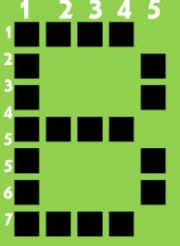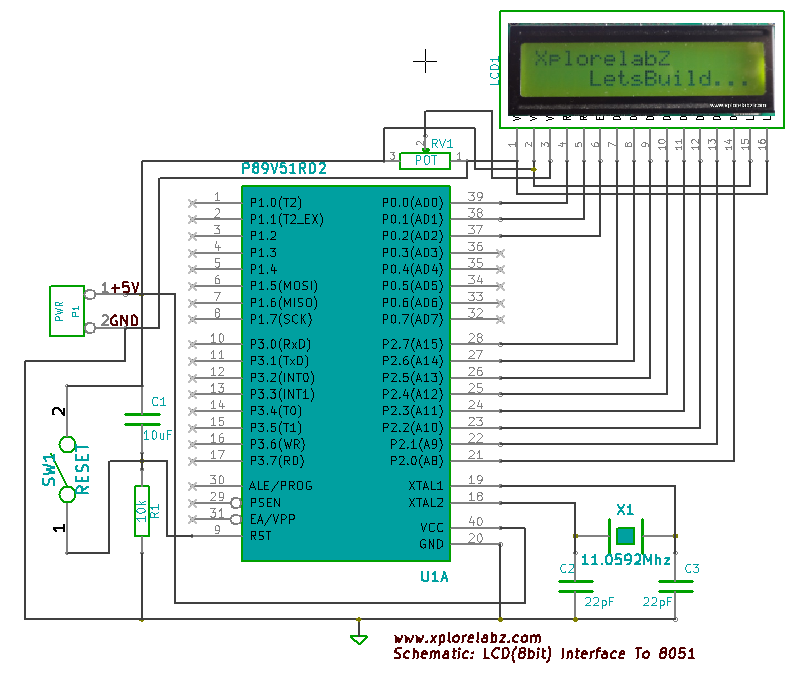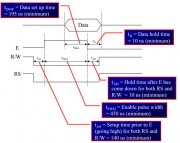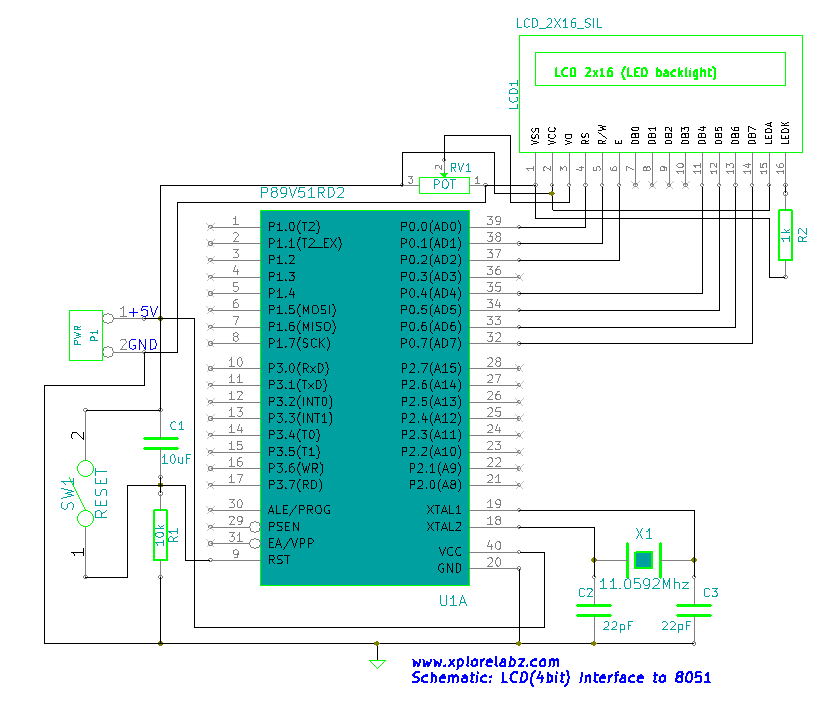Difference between revisions of "A1.8051 Interfacing:LCD 16x2"
| Line 372: | Line 372: | ||
====lcd_8_bit.c: 8 bit lcd library file==== | ====lcd_8_bit.c: 8 bit lcd library file==== | ||
{{Box|type=l_green_light|text= | {{Box|type=l_green_light|text= | ||
| − | Let us look at three important functons in ''' lcd_8_bit.c''' | + | Let us look at three important functons in ''' lcd_8_bit.c'''<br /> |
| − | 1. '''void LCD_CmdWrite( char cmd)''' | + | 1. '''void LCD_CmdWrite( char cmd)'''<br /> |
Commands are required to sent to lcd in order to set it up or initialize. | Commands are required to sent to lcd in order to set it up or initialize. | ||
The timing diagrams for command write are shown in the figure, | The timing diagrams for command write are shown in the figure, | ||
| + | [[File:LCD CmdWrite.jpg|thumbnail|figure: command write]]<br /> | ||
| + | *step1: Send the I/P command to LCD. | ||
| + | *step2: Select the Control Register by making RS low. | ||
| + | *step3: Select Write operation making RW low. | ||
| + | *step4: Send a High-to-Low pulse on Enable PIN with some delay_us. | ||
<syntaxhighlight> | <syntaxhighlight> | ||
void LCD_CmdWrite( char cmd) | void LCD_CmdWrite( char cmd) | ||
| Line 389: | Line 394: | ||
</syntaxhighlight> | </syntaxhighlight> | ||
| − | |||
| − | |||
| − | |||
| − | |||
| − | |||
| − | + | ||
| + | |||
}} | }} | ||
Revision as of 14:25, 25 December 2013
Contents
Introduction:LCD
Liquid Crystal Display(LCDs) provide a cost effective way to put a text output unit for a microcontroller. As we have seen in the previous tutorial, LEDs or 7 Segments do no have the flexibility to display informative messages. This display has 2 lines and can display 16 characters on each line. Nonetheless, when it is interfaced with the micrcontroller, we can scroll the messages with software to display information which is more than 16 characters in length.
LCD Internal Controller
The LCD is a simple device to use but the internal details are complex. Most of the 16x2 LCDs use a Hitachi HD44780 or a compatible controller. Yes, a micrcontroller is present inside a Liquid crystal display as shown in figure 1.
The Display Controller takes commands and data from a external microcontroller and drivers the LCD panel(LCDP). It takes a ASCII value as input and generate a patter for the dot matrix. E.g., to display letter 'A', it takes its value 0X42(hex) or 66(dec) decodes it into a dot matrix of 5x7 as shown in figure 2.
Basic Commands
The LCD controller uses RS and RW lines along with E to operate the LCD.
- Resister Select (RS): Determines weather a command(RS = 0) is sent (to set up the display) or actual data(RS=1) is sent.
- Read/Write RW=0; writes to the LCD. RW=1;Reads from the LCD.
The commonly used instructions are shown in the instruction set below. Observe the Bit names: I/D, S, D, C etc at the bottom of instruction set to decode the instructions completely.
- Clear Display
- Cursor Home
- Set Entry Mode
- Display on/off control
- Cursor/display shift
- Function Set
- Read Busy Flag
- Data Read
- Data Write
Instruction Set
| Instruction | Code | Description | ||||||||||
|---|---|---|---|---|---|---|---|---|---|---|---|---|
| RS | R/W | B7 | B6 | B5 | B4 | B3 | B2 | B1 | B0 | |||
| Clear display | 0 | 0 | 0 | 0 | 0 | 0 | 0 | 0 | 0 | 1 | Clears display and returns cursor to the home position (address 0). | |
| Cursor home | 0 | 0 | 0 | 0 | 0 | 0 | 0 | 0 | 1 | * | Returns cursor to home position. Also returns display being shifted to the original position. DDRAM content remains unchanged.
| |
| Entry mode set | 0 | 0 | 0 | 0 | 0 | 0 | 0 | 1 | I/D | S | Sets cursor move direction (I/D); specifies to shift the display (S). These operations are performed during data read/write.
| |
| Display on/off control | 0 | 0 | 0 | 0 | 0 | 0 | 1 | D | C | B | Sets on/off of all display (D), cursor on/off (C), and blink of cursor position character (B).
| |
| Cursor/display shift | 0 | 0 | 0 | 0 | 0 | 1 | S/C | R/L | * | * | Sets cursor-move or display-shift (S/C), shift direction (R/L). DDRAM content remains unchanged.
| |
| Function set | 0 | 0 | 0 | 0 | 1 | DL | N | F | * | * | Sets interface data length (DL), number of display line (N), and character font (F). | |
| Read busy flag & address counter |
0 | 1 | BF | CGRAM/DDRAM address | Reads busy flag (BF) indicating internal operation being performed and reads CGRAM or DDRAM address counter contents (depending on previous instruction). | |||||||
| Write CGRAM or DDRAM |
1 | 0 | Write Data | Write data to CGRAM or DDRAM. | ||||||||
| Write CGRAM or DDRAM |
1 | 0 | Write Data | Write data to CGRAM or DDRAM. | ||||||||
| Instruction bit names — I/D - 0 = decrement cursor position, 1 = increment cursor position; S - 0 = no display shift, 1 = display shift; | ||||||||||||
LCD UNIT
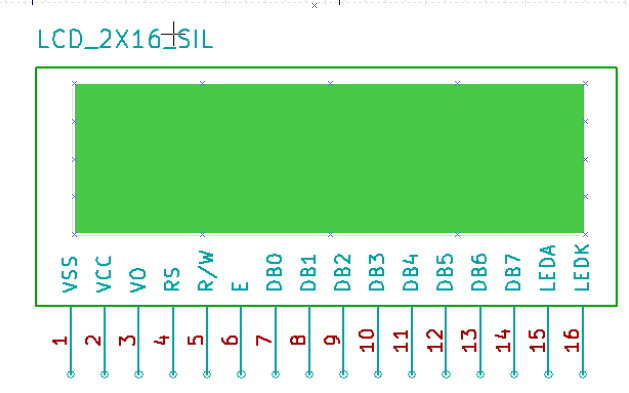 All the pins are identically to the lcd internal controller discussed above
All the pins are identically to the lcd internal controller discussed above
| PIN NUMBER | FUNCTION |
|---|---|
| 1 | Ground |
| 2 | VCC |
| 3 | Contrast adjustment (VO) |
| 4 | Register Select (RS). RS=0: Command, RS=1: Data |
| 5 | Read/Write (R/W). R/W=0: Write, R/W=1: Read |
| 6 | Clock (Enable). Falling edge triggered |
| 7 | Bit 0 (Not used in 4-bit operation) |
| 8 | Bit 1 (Not used in 4-bit operation) |
| 9 | Bit 2 (Not used in 4-bit operation) |
| 10 | Bit 3 (Not used in 4-bit operation) |
| 11 | Bit 4 |
| 12 | Bit 5 |
| 13 | Bit 6 |
| 14 | Bit 7 |
| 15 | Back-light Anode(+) |
| 16 | Back-Light Cathode(-) |
Interfacing LCD with 8051
8 bit Mode
Objective
There is lot of stuff that can be done with the LCDs, to start with we will simple display a couple of strings on the 2 lines of the LCD as shown in the image.
Schematic Discription
- Data Lines: In this mode, all of the 8 datalines DB0 to DB7 are connected from the micrcontroller to a LCD module as shown the schematic.
- Control Lines:' The RS, RW and E are control lines, as discussed earlier.
- Power & contrast:Apart from that the LCD should be powered with 5V between PIN 2(VCC) and PIN 1(gnd). PIN 3 is the contrast pin and is output of center terminal of potentiometer(voltage divider) which varies voltage between 0 to 5v to vary the contrast.
- Back-light: The PIN 15 and 16 are used as backlight. The led backlight can be powered through a simple current limiting resistor as we do with normal leds.
Schematic
Code
As with all the interfaces to simplify thing we have separated code into two files, main.c and lcd_8_bit.c. You may go through the tools setup tutorial on configuring the code.
The main.c is very simple it includes the standard library files. Then it uses several functions from the lcd_8_bit.c file to set up and display messages. As you can see, it makes things very simple when the libraries are well written. We will discuss the implementation while discussing the lcd_8_bit.c file.
The main file main.c
/* Reg51.h contains the defnition of all ports and SFRs */ #include <reg51.h> #include "lcd.h" //Xplore labz LCD library #include "delay.h" //Xplore Labz Delay library /* start the main program */ void main() { /* Initilize the lcd before displaying any thing on the lcd */ LCD_Init(); /* Display "hello, world" on first line*/ LCD_DisplayString("hello, world"); /*Go to second line and display "good morning" */ LCD_GoToLineTwo(); LCD_DisplayString("good morning"); while(1); }
lcd_8_bit.c: 8 bit lcd library file
1. void LCD_CmdWrite( char cmd)
Commands are required to sent to lcd in order to set it up or initialize. The timing diagrams for command write are shown in the figure,
- step1: Send the I/P command to LCD.
- step2: Select the Control Register by making RS low.
- step3: Select Write operation making RW low.
- step4: Send a High-to-Low pulse on Enable PIN with some delay_us.
void LCD_CmdWrite( char cmd) { databus=cmd; // Send the command to LCD rs=0; // Select the Command Register by pulling RS LOW rw=0; // Select the Write Operation by pulling RW LOW en=1; // Send a High-to-Low Pusle at Enable Pin delay_us(10); en=0; delay_ms(1); }
#include<reg51.h> #include "delay.h" #include "lcd.h" #define databus P2 // LCD databus connected to PORT2 sbit rs= P0^0; // Register select pin connected to P0.0 sbit rw= P0^1; // Read Write pin connected to P0.1 sbit en= P0^2; // Enable pin connected to P0.2 /* 16x2 LCD Specification */ #define LCDMaxLines 2 #define LCDMaxChars 16 #define LineOne 0x80 #define LineTwo 0xc0 #define BlankSpace ' ' void LCD_Init() { delay_us(5000); LCD_CmdWrite(0x38); // LCD 2lines, 5*7 matrix LCD_CmdWrite(0x0E); // Display ON cursor ON Blinking off LCD_CmdWrite(0x01); // Clear the LCD LCD_CmdWrite(0x80); // Cursor to First line First Position } void LCD_CmdWrite( char cmd) { databus=cmd; // Send the command to LCD rs=0; // Select Command Register by pulling RS LOW rw=0; // Select Write Operation by pulling RW LOW en=1; // Send a High-to-Low Pusle at Enable Pin delay_us(10); en=0; delay_ms(1); } void LCD_DataWrite( char dat) { databus=dat; // Send the data to LCD rs=1; // Select the Data Register by pulling RS HIGH rw=0; // Select the Write Operation by pulling RW LOW en=1; // Send a High-to-Low Pusle at Enable Pin delay_us(10); en=0; delay_ms(1); } void LCD_GoToXY(char row, char col) { char pos; if(row<LCDMaxLines) { pos= LineOne | (row << 6); // take the line number //row0->pos=0x80 row1->pos=0xc0 if(col<LCDMaxChars) pos= pos+col; //take the char number //now pos points to XY pos LCD_CmdWrite(pos) } } void LCD_DisplayString(char *string_ptr) { while(*string_ptr) LCD_DataWrite(*string_ptr++); } |


